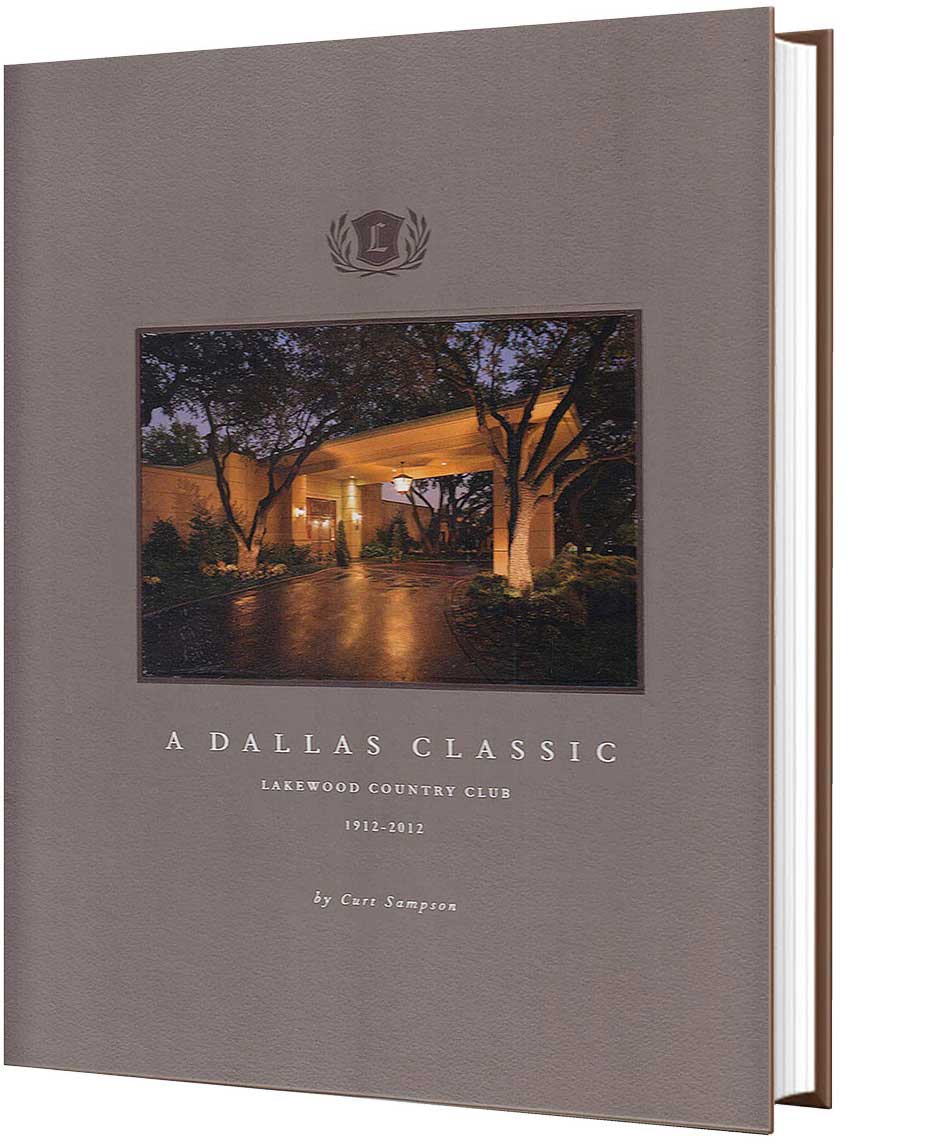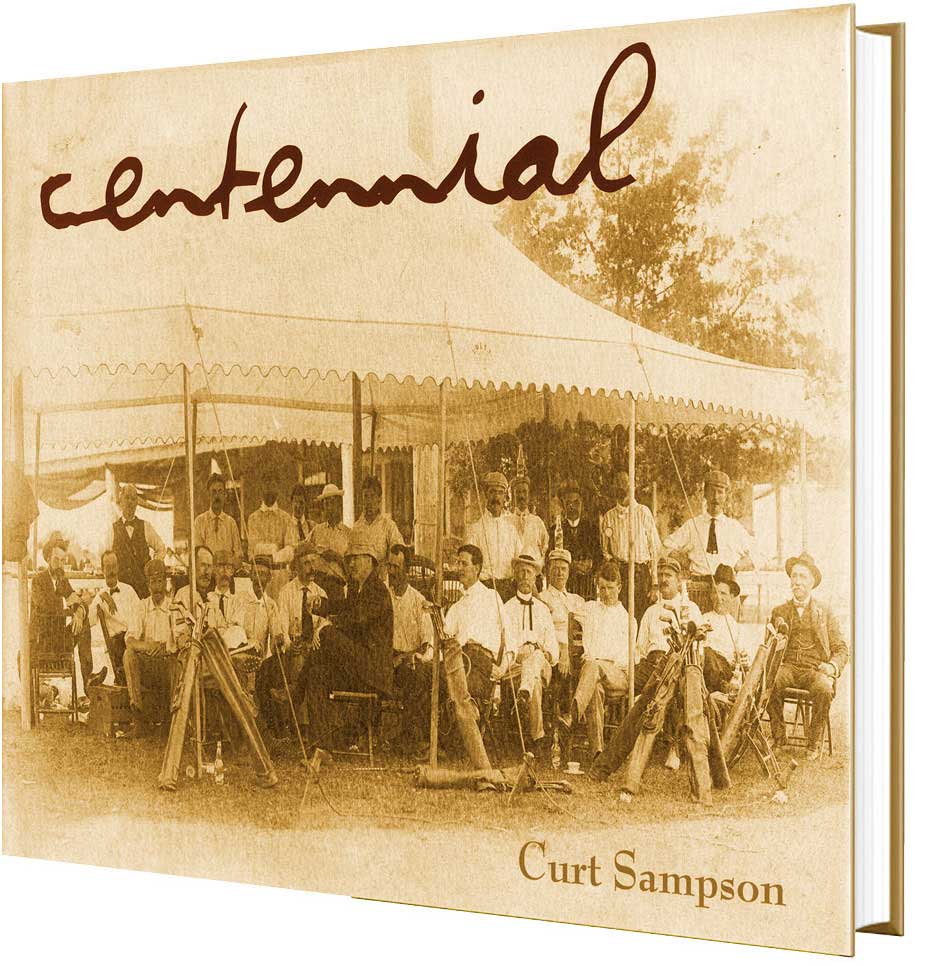
Golf, The Greatest Game
Introduction by John Updike. Reflections on the Game by Arnold Palmer
Published by HarperCollins, 1994
To celebrate its 100th birthday in 1994, the United States Golf Association (USGA) funded a centennial coffee table book, which was published in conjunction with a TV documentary. Curt Sampson and John Strawn were among the roster of writers recruited to compose essays on various aspects of the USGA’s history. Joining Tom Doak, Jaime Diaz, and John Updike as contributors, John’s chapter reviewed key moments in the USGA’s first one hundred years, while Curt wrote a perceptive essay about the role clubhouses played in the evolution of country clubs, American golf’s unique contribution to the game.
The book is beautifully illustrated, with images reaching back into the 19th century. Publisher’s Weekly noted that the “most spectacular” photos were “the shots of famous courses, bearing out Updike’s observation that those who play the game ‘breathe natural vastness’.”
More About Golf The Greatest Game
As an admirer of John Updike, I was thrilled to share a by-line with him as a contributor to Golf. The Greatest Game. I wrote this appreciation of Updike’s collection of golf writing in 2010.
John Updike was the literary Sam Snead. Golf Dreams: Writings on Golf, published in 1996, was his 49th book, a miscellany of golf-related short stories, essays, excerpts from novels and the occasional poem. As a writer, Updike was long and straight. He was also a natural who strode onto the first tee of the Writer’s Tour with a perfected style, his prose as supple and smooth as Snead’s fluid swing, and as enduring.
Golf was a recurrent motif in Updike’s work. This handy distillation provided readers not only with a compendium of Updike’s golf prose, but with his own running commentary about the origins and publishing history of the collected pieces.
Able to support himself as a writer practically from infancy – a staff writer for The New Yorker right out of Harvard, he was free-lancing full time by his mid-20s – Updike lived the suburban life much of his fiction centered on. As he observed in his memoir, Self-Consciousness, he had “learned to play the rich child’s games of tennis and golf,” in his mid-20s, after moving to Ipswich, Mass.
Smitten with the game, and possessing more free afternoons each week than the average working stiff has in a year, Updike not only played golf often, he immediately put his experience to good use by placing golf clubs in the hands of his characters.
Updike in autumn was awakening from his golf dreams, the hope nourished in every golf traveler’s soul that some ultimate improvement lies just over the horizon. Golf magazines, with their endlessly repeated tips and discoveries, feed off of this longing. ”The suspicion crept over me,” Updike wrote in the preface to Golf Dreams, “that golf had stolen my life away: the hard gemlike flame with which I, an artist, should have burned had been dampened if not doused by the green mists of this narcotic pastime.”
The glow of Updike’s flame was amply blight, those “green mists” notwithstanding. The earliest stories, mostly written for The New Yorker, carried not merely hints of the greatness to come but its full expression. “Intercession,” chronologically the first Updike golf story, contains this line: “Then, so gently he might have been hooding a falcon, he fitted the golden head of his club with a chamois cover.” This is echt-Updike, this ability to capture an everyday moment with a simple image that displaces routine with poetry.
Updike’s best-known character, Rabbit Angstrom, was a steady denizen of the links once he escaped the gravitational pull of his youthful orbit. In excerpts from the four Rabbit novels in Golf Dreams, we see Rabbit evolving from early manhood to middle age: the vigorous, if confused hoopster stalking the “pagan groves and green alleys” of youth will eventually sink into a Florida dusk of golf carts, conceded putts and angioplasty.
Who else but Updike could write that “all swing thoughts decay, like radium,” or describe the aural sensation of a ball leaving the clubface as a “pleasant tearing sound, as if pulling a zipper in space”?
Updike “read about golf, with great pleasure,” he wrote in Golf Dreams, “long before I played it.” Then, having played golf, he compounded the delight for devotees of golf literature by adding these marvelous chapters to golf’s bulging shelf. I can’t imagine anyone devoted to golf’s literary treasures not finding delight in this unassuming, captivating book.

Creating Calusa Pines
A Story of Hope and Determination
Published by Calusa Publishing, October 2019
Gary Chensoff was a successful Chicago real estate developer who began accumulating property in southwest Florida in the late 1990s. He planned to build both a public course for golf tourists and a high-end private club with an exclusive membership available by invitation only. After three years of shepherding the project through permitting, on the eve of construction getting underway, Chensoff was diagnosed with stage four cancer.
Creating Calusa Pines reports the astonishing tale of Chensoff’s treatment and recovery and how his determination to create a world-class golf course sustained him through the darkest times. Ron Whitten of Golf Digest praised Creating Calusa Pines, calling it “a hefty volume that belongs on the bookshelf of every golfer who has even a passing interest in golf course architecture. This club history is almost as fascinating as the golf course itself.”
More About "Creating Calusa Pines"
Ron Whitten on Creating Calusa Pines, A Story of Hope and Determination, by John Strawn of Strawn & Sampson
“I’m not much of a fan of club histories, mainly because they usually consist of members pointlessly backslapping one another, relegating the whole purpose for the club – the golf course – to a scant few pages.
“This is why I feel John Strawn’s 2019 club history, Creating Calusa Pines – A Story of Hope and Determination, is so extraordinary. The whole book is about the important stuff, the creative process behind the design and construction of one of the great golf courses in the world, Calusa Pines in Naples, Florida. The book combines the drama of a great novel – Calusa’s developer Gary Chensoff was battling cancer, with bleak prospects of survival, at the beginning – with nuggets of well-researched history – did you know the sand beneath Florida came from the erosion of the Appalachians a quarter million years ago? – all woven into a compelling narrative that describes how a flat piece of Florida jungle was transformed into a startlingly unique golf layout containing hills up to 58 feet high.
“It’s not just a fascinating read, it’s a compelling treatise on golf design. I’ve studied the subject for over 50 years and thought I knew everything, but Creating Calusa Pines gave me fresh ideas, like Chensoff’s insistence that no lake on his golf course be seen in its entirety from a single vantage point. Beautifully illustrated, Creating Calusa Pines is a hefty volume that belongs on the bookshelf of every golfer who has even a passing interest in golf course architecture. This club history is almost as fascinating as the golf course itself.”
Ron Whitten is the long-time Architecture Editor for Golf Digest and co-author of The Architects of Golf.
Prominent Golf Course Architect Dan Hixson Comments on Creating Calusa Pines, A Book Commemorating the Club’s 20th Birthday.
Dan Hixson shared his impressions after reading Creating Calusa Pines, A Story of Hope and Determination.
“The only thing I knew about Calusa Pines before reading Creating Calusa Pines was its location in Naples, Florida, where I had played years before Calusa Pines was built during my brief run as a touring professional.
“John Strawn has delivered a comprehensive account of the making of the golf course that is both thorough and entertaining. John’s research into the individuals involved in Calusa’s creation, and all the events that took place from land acquisition to planning and design to construction and grow-in, was broad and deep.Along with the photos, drawings and maps, all of which help move the story forward, John uncovered details and discovered historical connections between Calusa Pines and other great courses that most of us would never know.
“Strawn’s books, which include Driving the Green, which I read thirty years ago when my ideas about golf design were just beginning to take shape, are simply a must read for anyone interested in the complexities of how golf courses are created. John brings a unique set of writing skills, golf course design knowledge and imagination to his writing. I doubt that Gary Chensoff, the owner of Calusa Pines, could have imagined such a finely written history of his dream golf course–and based on the portrait of Chensoff that John draws in Creating Calusa Pines, Chensoff thought of everything.”
About Dan Hixson
Dan Hixson knew he wanted to design golf courses from the age of seven, when his father took him to see the re-design underway at Eugene Country Club, where Robert Trent Jones famously reversed the routing. Hixson played golf at Oregon State, briefly chased the dream of a career as a touring pro, and then, as his father and brother had before him, took on the role of club professional.
As he rose through the ranks as an assistant pro at various Oregon clubs, signing on as Head Professional at Columbia Edgewater in the mid-80s, Dan never abandoned his boyhood goal of designing courses. By 1999, he was ready to hang out his shingle as a course designer, taking on small renovation jobs at local courses to start. His big break came in 2005, when he was hired to design Bandon Crossings, on the edge of the town made famous in golf circles by Mike Keiser’s decision to build America’s first true links course there in the 1990s. Bandon Dunes’ remarkable success facilitated Hixson’s breakout inaugural design.
Hixson’s next project, Wine Valley in Walla Walla, Washington, did for Dan what Bandon Dunes had done for David Kidd: it announced the arrival of a major new talent in golf course architecture. Wine Valley is a perennial in Golfweek’s Top Modern Courses, and is in the top five of Golf Digest’s courses you can play in Washington.
Dan’s follow-up to Wine Valley at Silvies Valley Ranch in eastern Oregon showcased his creativity on a complicated but alluring site. Given free rein by the ranch’s owner, Hixson created a reversible course, with 27 greens and 36 sets of tees, meandering through dramatic terrain with spectacular scenery. A working ranch of 144,000 acres, it raises organic beef and a proprietary breed of goats, who share the verdant landscape with elk, deer, beaver, bear, and an abundance of bird species. Hixson took full advantage of the ranch’s extraordinary tranquility to create a golf course which nourishes the spirit.
Tom Dunne, a Founding Editor of McKellar, A Golf Companion, and an Architectural Panelist at Golfweek, writes that
“Creating Calusa Pines is no ordinary club history. The first thing the reader notices is that John Strawn, thanks to his deep background in golf course design, has the rare ability to explain the technical details of course construction in an engaging manner. But his work goes well beyond the golf course itself. Instead of dry recitations of bygone club championships, Strawn explores the fascinating history of southwest Florida from the native Calusa people to the machinations of the modern real estate industry. Finally, his account of the courage and perseverance displayed by founder Gary Chensoff, who developed the club during cancer treatment, gives Creating Calusa Pines an emotional resonance that is seldom seen in the genre.”
View a digital version of Creating Calusa Pines here
(after creating a free account)

A Dallas Classic
Lakewood Country Club 1912-2012
I like writing club histories because I like history. But is the re-telling of a country club’s life a worthy pursuit, does it rise to the level of capital h History? Yes, I say. “By putting Lakewood’s history between hard covers,” I wrote in 2012 in A Dallas Classic, the club’s 100-year commemorative book, “we are contending that the story of an enduring country club is a perfectly good lens through which to view the entire Sturm und Drang of the last century.”Before I wrote A Dallas Classic, I’d read enough club commemorative books to know that they were often mind-numbing volumes dedicated to a club slapping its own back, or an attempt to provide more or less permanent reminders of who won B Flight in the 1972 Member-Guest. Posterity, in the form of History, does not care who won B Flight in the ’72 Member-Guest and neither do I. Neither, more importantly, do readers.
More about "A Dallas Classic"
“A lot of our records had been lost over a century in business and we didn’t produce a book for our 50th or 75th anniversaries, so we didn’t give Curt a lot to go on. But we were delighted with A Dallas Classic, which is fun, readable and informative. Our existing members loved it, and every new member got a copy as our welcoming gift.”
—Ray DiTulio, General Manager, Lakewood Country Club

Centennial
Texas Golf Association, 100 Years
I applied the same focus on context, personalities, and anecdote in subsequent histories of Sage Valley Golf Club in South Carolina (A Vision, Not a Blueprint) and Metedeconk Country Club in Maine (Come Play in My Backyard).
Capturing the sweeping history of a century-old golf association provided a different challenge. There was no one club house or golf course, for example, and no single architect or golf pro. But the effect of big events on the institution—wars, the Depression, and so on—were the same as on a golf club. And in the dusty record books I re-discovered dimly remembered old friends, such as Gus Moreland, a contemporary of Ben Hogan and Byron Nelson and a TGA champion in the 1930s:
“Moreland possessed a foghorn voice and a case of logorrhea,” I wrote, “a combination that would qualify him to announce football games today. In fact, he liked to do a sort of play-by-play description of his own game, most famously when he had a long putt. He’d stroll toward the hole while the ball rolled…and offer comments on the ball’s progress and its chance of going in that were impossible not to hear. He was an infuriatingly good putter, so his opponents often had to suffer through his descriptions of his own success.”
Centennial succeeded, I think, for two reasons: there was a great story to tell, and the author—me—did not get in its way. Hard research and a humble attitude are, in my opinion, key to producing an informative, readable narrative.
“Centennial was a hit with our members. All of us who read it—even those of us who’ve been in and around the TGA for a long time—learned something new. And Curt weaved it all together in such an entertaining way. We’re really proud of our organization and of this book.”
—Rob Addington, Executive Director
Texas Golf Association, 2001 -2015
